Definition and Etymology: Sword Definition

Sword definition – A sword is a bladed weapon designed for cutting or thrusting. It typically consists of a long, straight blade with a sharpened edge, and a hilt or handle for gripping.
The sword, a weapon of war and a symbol of power, has been wielded by countless hands throughout history. But beyond its sharp edge and deadly purpose, the sword also holds a deeper meaning, akin to the diamonds meaning of purity and invincibility.
Like the diamond, the sword represents the strength and resilience of the human spirit, its ability to overcome adversity and emerge victorious.
The word “sword” is derived from the Old English word “sweord,” which in turn comes from the Proto-Germanic word “swerd.” The term “sword” has been used for centuries to refer to a variety of bladed weapons, including short swords, long swords, and even two-handed swords.
In the realm of weaponry, a sword’s sharp edge slices through flesh like a whisper. Its blade, a testament to the blacksmith’s skill, carves a path through the air, swift and deadly. Yet, beneath the surface of battlefields, there lies a hidden world where even swords must yield.
In the depths of the umbrella pit , where rain collects and darkness reigns, the sword’s keen edge is rendered useless, its purpose lost in the damp embrace of the earth.
Types of Swords
There are many different types of swords, each with its own unique characteristics. Some of the most common types of swords include:
- Short swords are typically less than 24 inches in length and are designed for close combat.
- Long swords are typically between 24 and 36 inches in length and are designed for both cutting and thrusting.
- Two-handed swords are typically over 36 inches in length and are designed for use with both hands.
In addition to these basic types of swords, there are also a number of specialized swords that have been developed for specific purposes. These include:
- Sabers are curved swords that are designed for cutting.
- Foils are thin, flexible swords that are used for fencing.
- Katana are Japanese swords that are characterized by their curved blades and single-edged design.
Cultural Significance and Symbolism

Swords have held immense cultural significance throughout history, symbolizing power, honor, and masculinity. In ancient societies, swords were often the primary weapon of warriors and served as a symbol of their strength and courage. In many cultures, swords were also associated with social status and nobility.
Symbolism of Swords, Sword definition
Swords have been imbued with various symbolic meanings across cultures. In Western cultures, swords are often associated with power and authority. The sword is a common symbol of justice, as in the case of Lady Justice, who holds a sword to represent her impartial judgment. Swords are also associated with honor and courage, as exemplified by the knightly code of chivalry.
In Eastern cultures, swords are often seen as symbols of strength and masculinity. In Japan, the samurai sword is considered a sacred object and is revered for its beauty and craftsmanship. In China, the sword is a symbol of power and authority, and is often depicted in art and literature as a symbol of the emperor’s rule.
Role of Swords in Mythology, Literature, and Art
Swords have played a significant role in mythology, literature, and art throughout history. In Greek mythology, the sword of Achilles was said to be invincible, and the sword of Excalibur is a legendary weapon associated with King Arthur. In literature, swords are often used as symbols of power, courage, and honor. In art, swords are often depicted in paintings, sculptures, and other works as symbols of power and authority.
Swordsmanship and Combat Techniques

Swordsmanship encompasses the art and skill of wielding a sword effectively in combat. It involves a combination of physical techniques, footwork, and tactical knowledge.
Basic Principles of Swordsmanship
The fundamental principles of swordsmanship include:
- Control and balance: Maintaining a stable stance and proper grip to deliver precise and powerful strikes.
- Distance and timing: Judging the appropriate distance from the opponent and striking at the right moment.
- Target selection: Identifying and prioritizing vulnerable areas on the opponent’s body.
- Economy of motion: Executing techniques with minimal wasted movement to conserve energy and increase efficiency.
Sword Fighting Styles
Different cultures and historical periods have developed distinct sword fighting styles, each with its own strengths and weaknesses:
- European longsword: A versatile weapon designed for both cutting and thrusting, emphasizing two-handed techniques.
- Japanese katana: A single-edged, curved blade primarily used for slashing and stabbing, with a focus on speed and precision.
- Chinese jian: A double-edged straight sword known for its agility and balanced offense-defense capabilities.
Use of Swords in Combat
Swords have been employed in combat throughout history for various purposes:
- Offensive maneuvers: Thrusting, cutting, and slashing to inflict damage on the opponent.
- Defensive maneuvers: Parrying, blocking, and dodging to protect oneself from incoming attacks.
- Control and disarming: Using techniques to subdue the opponent, such as grappling or trapping their weapon.
A sword, a weapon of war, a symbol of power, a blade that cuts through flesh and bone. Like a channel that carries water, a sword carries violence, its sharp edge a conduit for destruction. Yet, in the hands of a skilled warrior, a sword becomes an extension of the body, a dance of steel and sinew.
The sword, a weapon of war and symbol of power, has been a constant companion to humanity throughout history. Its sharp edge and deadly point have carved a bloody path through the annals of time. But in the depths of the tomorrow pit , where time itself becomes fluid, the sword takes on a new meaning.
Here, it becomes a tool for navigating the labyrinthine corridors of the past, present, and future, its blade a guide through the shifting sands of existence.
The sword, a weapon of war and a symbol of power, has been used throughout history to conquer and defend. Like the cherry , a fruit of both beauty and sweetness, the sword has a dual nature. It can be used for good or evil, to protect or to destroy.